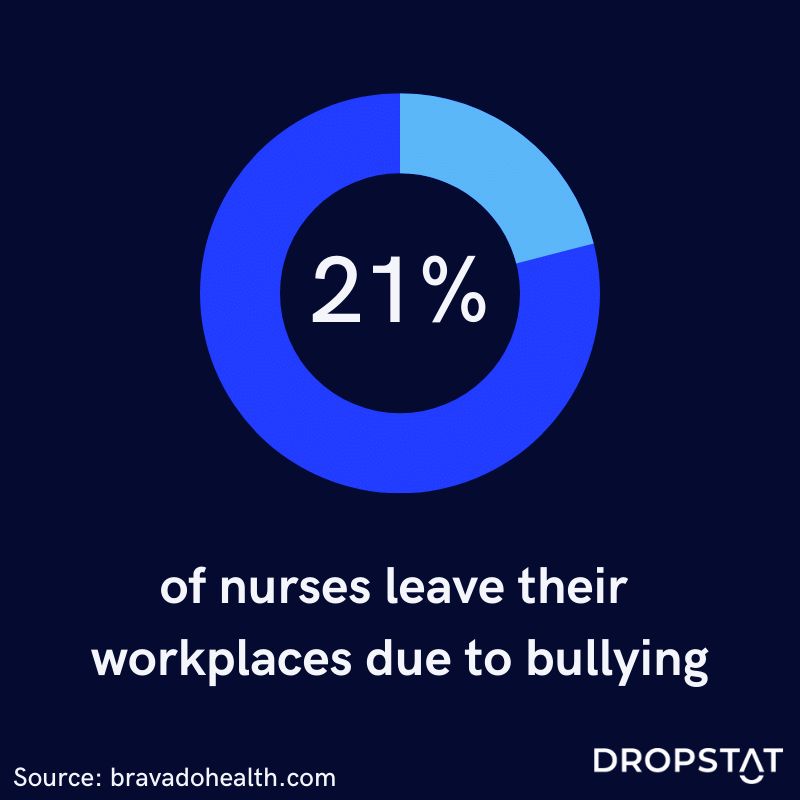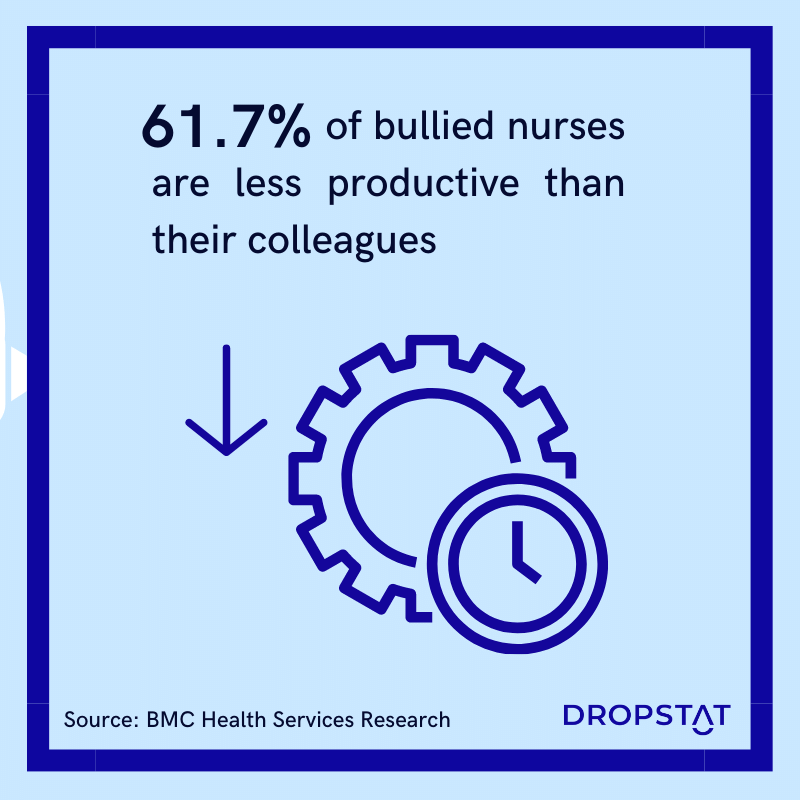What is Nurse Bullying?
The American Nurses Association defines nurse bullying as “repeated, unwanted harmful actions intended to humiliate, offend and cause distress in the recipient.” It is also known as “new graduate nurse bullying” since it is mainly perpetrated against newer nurses. Their lack of confidence and social connections makes them more vulnerable.
Workplace bullying is a real issue in healthcare facilities, and unfortunately, bullying and incivility in nursing seem to be an accepted part of a nursing career. Nurses are typically so stressed that about 50% of surveyed nurses consider leaving the profession. Workplace bullying of nurses often comes from the people they repeatedly meet in the facility framework, i.e., their colleagues or nurse managers. This is known as horizontal or lateral bullying.
Types of bullying in nursing
Typical workplace bullying scenarios in nursing include
- Other nurses or managers interfering in a new nurse’s work activities or nitpicking.
- Fellow staff showing disapproval through criticism, nasty remarks or slander
- Nurses taking revenge in a circumventing manner
- Nurses ignoring, distrusting, or unfairly blaming a fellow nurse
- Threatening a nurse verbally or even physically. Being ignored, distrusted, or unfairly blamed is also typical in the nursing work environment.
Stats and facts on workplace bullying in healthcare facilities
The Joint Commission describes bullying as deliberate intimidation of nurses. The ‘poison arrows’ find their mark as the victim senses that they are being targeted.
How prevalent is bullying and incivility in nursing?
Numerous studies have been carried out on horizontal bullying in nursing. Here are some of the shocking stats.
- 85% of nurses reported experiencing nurse-to-nurse verbal abuse.
- Thomas & Burk (2009) reported that in clinical rotations, nursing students experienced feeling humiliated and insulted; this was especially noticeable in new graduate nurses.
- An RNNetwork survey found: that 45% of nurses were verbally harassed by other nurses and 41% by managers and administrators.
- Nearly 50% of surveyed nurses considered leaving nursing altogether because they felt they were not respected by admin and/or staff.
What are the costs of bullying in the workplace?
Nurse bullying not only creates a lot of tension and emotional damage; it also comes with a hefty price tag. When a nurse leaves the profession due to bullying, the nurse turnover costs between $27,000-$103,000!
A shocking 21% of nurses leave their workplaces due to bullying-related reasons. (Do the others remain in their jobs as miserable nurses? Do they become the bullies of the next generation?)
Who wants to stay in an organizational culture where they are made to feel they are incompetent and experience bullying behavior?
When victims of nurse bullying don’t leave, they often suffer “lower morale, lower productivity, and increased absenteeism,” which costs the facility in lost productivity and labor costs. This toxic environment makes a self-defeating workforce!
Furthermore, the costs of bullying in the workplace include impacted patient trust and care. Patients receive less-than-quality care from bullied nurses who may be sour, impatient, or unkind because they are suffering emotionally. Even more concerning is the fact that the victim nurses may be so preoccupied with their emotional turmoil that they may make more mistakes in patient care. A lack of attention when dealing with medication and dosages can be life-threatening.
How to Prevent Nursing Bullies
The first step to preventing nursing bullies is awareness at every level of the healthcare facility management, from CEO to charge nurse. Once there is awareness, someone has to accept responsibility and make some changes.
Many things can be done to help improve the situation for nurses in a facility. Take advantage of tools that are available to improve work conditions for your staff and reduce the financial, emotional, and other costs of horizontal bullying in nursing. Here are some ideas:
- Establish a confidential system for nurses to report bullying. Enable them to speak up and share their pain instead of swallowing it. Apps like the Not Me App or Report App allow your staff to report harassment through an app on their phone confidentially so you can pick up on problematic bullying cases before they escalate.
- Ensure that your workplace culture places significant value on newer nurses’ knowledge and skills. This can help eliminate seniority bullying from more established staff and management who want to abuse their authority. Long-time staff may be senior, but they may be stale. Newer staff might actually have an edge over the lords of the lab coats as they may be more up-to-date on the newest research and procedures. Create lateral learning programs or even buddy systems in which senior staff show newer staff the ropes of the facility, but newer nurses also share their more updated knowledge. Making your workplace learning-oriented shifts the value from seniority to expertise. With this positive culture, staff can respect and appreciate both the experience of veterans and the fresh perspective of newcomers.
- Institute a biannual complimenting activity within the nursing staff. Offer small bonuses or gift cards to encourage participation. Focusing on colleagues’ good qualities and building positive relationships between staff can significantly reduce bullying.
- Purchase a program to deal with lateral violence in your facility. (Such as The Bully Free® Program for schools and workplaces ) or have the Olweus Bullying Prevention Program (OBPP) that can be adapted specifically for your facility.
- Build your staff’s confidence and develop their personalities. Use an enrichment program and reward nurses for positive attitudes. Both bullies and victims can gain a lot from career development and personal investment. It might just take a little bit to build their confidence to either stand up to the bullying or no longer feel the need to bully to feel professionally secure.
Frequently Asked Questions
Am I aware of bullying in my facility?
To become aware of bullying in your facility, call your staff, either for a face-to-face or remote meeting. Ask them to share their experiences and ask for examples. Have a look at the videos of the security cameras in your facility. Look at the body language in staff interactions. It’s your own private investigation. If needed, call in an HR professional to improve the situation.
Does bullying and harassment among my nursing staff affect my patients’ care?
Absolutely. The nurses feel it, and the patients and their family members might wish they were 1,000 miles away. Ask your patients for anonymous feedback about staff dynamics. Prepare a short questionnaire to encourage patients to provide honest feedback so you can get an inside look at your staff’s dynamics. It might be surprising to see just how much nurse bullying affects patient care.
What are the other benefits of preventing nurse bullying in my facility?
Well, you want your staff to be happy and healthy in the same way you want your patients to be. You can save a lot of money by preventing nurse turnover. You can save time by avoiding staff absenteeism due to bully-related misery. Look through the paperwork. Why have staff left your facility over the years? Look for a common pattern.
How can we foster team spirit amongst nurses?
Get-togethers and continuing education days are popular ways of encouraging a team spirit among staff in all professions. Celebrate Nurse Day for your staff in a unique way and encourage your patients and their families to do the same. Build up the morale among your nurses by showing them that they are valued by administration and patients alike. Put on a nurse’s display (such as the history of nursing). The staff will enjoy seeing themselves in the limelight, and they would be automatically appreciated more by those around them.
Nurse Bullying Takeaway
Dealing with nurse bullying in your facility will help you reduce nurse turnover and patient dissatisfaction. You can only fight nurse bullying once you understand what it is and the effects it has on your facility. When you are aware of the true situation in your workplace, you can find the tools to make it a more pleasant place to work and receive care.








